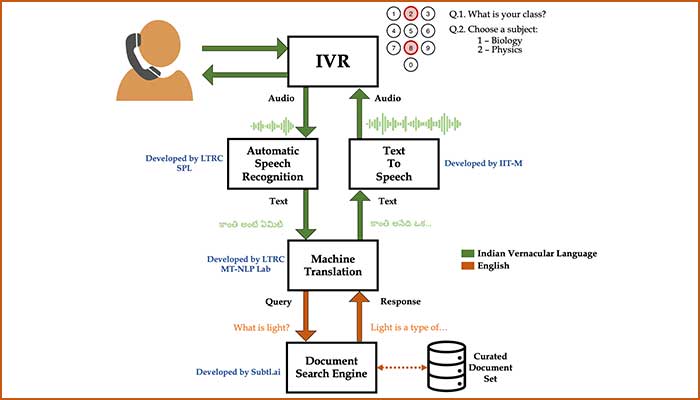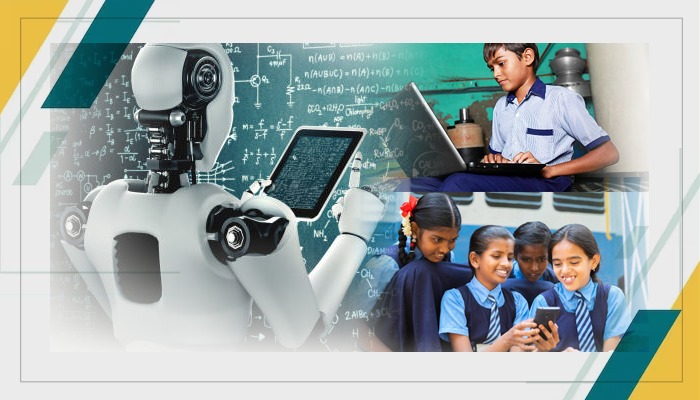A multi-partner project spearheaded by the Raj Reddy Center for Technology and Society aims to supplement high school Science instruction in regional languages via an AI solution that operates sans internet.
“Kanti ante yemti”? (What is light?), asks Lakshmi* (name changed to protect identity), a diminutive 12-year-old from a government school in Vizianagaram, AP. The question is however not posed to any one in particular but instead directed into the mouthpiece of a phone. A few seconds later, an automated voice responds, providing a detailed explanation – all in Telugu. Lakshmi is one of the many rural school children that the AskAgastya project, an initiative by Prof Raj Reddy Center for Technology and Society (RCTS) in collaboration with Agastya Foundation aims to reach as part of democratising access to Science curriculum-based information in the absence of the internet.
The idea of using technology to solve socially relevant problems is at the crux of RCTS’ mission which is currently focused on education and healthcare, for which it has partnered with several NGOs. The Agastya Foundation, an NGO that was set up primarily to augment government school curricula uses novel learning methodologies to spark curiosity in rural students. “They started a telephone-based voice call service for students where students could dial a number and ask questions to a teacher. Around a year ago, they approached us and asked if we could automate it using AI,” says Ramesh Loganathan, Professor of Practice and Co-Innovations, IIITH, explaining the genesis behind the project.
Why AI?
Terming it a completely new idea, Mr. Sastry Adiraju, CTO, Agastya Foundation, says, “Our target beneficiaries don’t necessarily have access to the internet and a smart phone or a laptop or any such device. The idea is that if they have some questions, how can they go about addressing them. Hence the proposal was to enable them to put across their questions through the minimum available medium like a voice phone, either a mobile or even a landline. Essentially the driving force is that limited or minimal resources should not disadvantage a child.” While urban school children with doubts after school, immediately reach out to the internet and look up their queries online, it’s not the same for the rural children. “With AskAgastya, we are giving these children an opportunity to clear their doubts immediately, without having to wait for the next day of school so that their motivation to learn is not hampered,” reasons Dr. Arjun Rajasekar, Senior Research Scientist, RCTS.
The Pipeline
The project has seen the combined efforts of IIITH’s language technologies expertise in conjunction with IIT Madras providing a text-to-speech conversion as well as a Hyderabad-based start up, Subtl.ai assisting with a Doc AI solution. To illustrate the manner in which the various technologies come together, let’s revisit Lakshmi’s query. The AI-driven IVR system kicks in with her ‘Kanti ante yenti?”. The audio is recorded and goes through a Speech Recognition Module developed by the Speech Processing Lab of the Language Technologies Research Centre (LTRC) where it gets extracted by AI into Telugu text. The text then undergoes a translation into the English language – “What is light?” – with the help of the Machine Translation and NLP Lab. This query is then put through a document search engine developed by Subtl.ai that trawls through NCERT and SCERT (state syllabus) Physics curricula for high school grades of 8th, 9th and 10th, before the accurate answer is retrieved and presented. Since the response is still in English, the text again goes through the machine translation module where it is translated into Telugu text. When the text is converted to Telugu speech, Lakshmi hears the explanation she had sought.

Fine-Tuning And Expanding
One of the biggest challenges that the group is currently attempting to surmount is the lack of quality data of children’s speech forms. “Unlike adult speech which is coherent and free-flowing, children posing questions to the system may be shy, speak haltingly, incoherently or even repeat words. Most models are not designed to accommodate such ‘imperfect’ speech,” says Dr. Rajasekar. Given that the end-users are school-going children, the goal is to create a system that works flawlessly for them. The process of finetuning the models is happening via a pilot through the Agastya Foundation where the team hopes to reach 1600 schools across Andhra Pradesh and Telangana. While the initial phase targets Physics and Biology in Telugu, plans are afoot to expand the offering to include other subjects and make it available in other regional languages too.



Next post